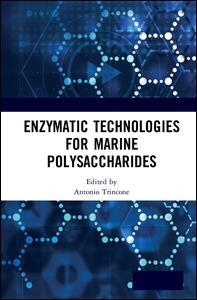Enzymatic Technologies for Marine Polysaccharides
Coordonnateur : Trincone Antonio

The bioactivity potential of marine polysaccharides has long been considered an underexploited aspect. These molecules found in seaweed, microalgae, bacteria, and animal fish (shellfish, mollusks, etc.) and the derived oligosaccharides need to be explored thoroughly with an interdisciplinary approach. They are an extraordinary source of chemical diversity, and the literature highlights many applicative fields, including the food industry, cosmetics, biomedicine, agriculture, environmental protection, wastewater management, etc. More recently, a new challenge has emerged: the exploitation of marine biomass as the source of sustainable energy to participate in the future replacement of fossil resources. Enzymatic Technologies for Marine Polysaccharides provides insight into the recent research developments of marine polysaccharides and their current and potential applications.
The first section of the book explores the diversity of marine polysaccharides from various angles, including a description of the chemical complexity and current applications and new perspectives in food, pharmaceutical, cosmetics, and biomaterials offered by recent research. Efficient valorization of the marine polysaccharide biomass requires a rigorous analysis of the polysaccharides structure and their biological properties. The second section of the book concerns the development of extraction techniques and the improvement of the methods aimed at the characterization of their structure and function. Finally, the third and last section of the book articulates the enzymatic technologies from the discovery of novel enzymes to their production pipelines related to the fields of biorefinery, food, pharmaceutics, and other fine chemicals.
- Presents the latest research in marine oligosaccharides and polysaccharides
- Written by world-class researchers in marine enzyme technology
- Discusses the latest developments in extraction methods
- Presents a detailed overview of enzymatic routes for modification, production, and synthesis of marine oligosaccharides
- Contains extensive references at the end of each chapter to enhance further study
Section 1: General view and sources of marine polysaccharides and oligosaccharides 1. Marine biodiversity as a new source of promising polysaccharides: innovative polysaccharides emerging from the marine biodiversity 2. Applications of marine polysaccharides in food processing 3. The manufacture, characterization, and uses of fucoidans from macroalgae 4. Chemical and biological routes for the valorization of macroalgal polysaccharides 5. Marine exopolysaccharides provide protection in extreme environments 6. Structural mechanisms involved in mild-acid hydrolysis of a defined tetrasaccharide-repeating sulfate fucan 7. Biosynthesis and extrusion of β-chitin nanofibers by diatoms 8. The mucus of marine invertebrates: Cnidarians, polychaetes, and echinoderms as case studies 9. Biorefinery of unique polysaccharides from Laminaria sp., Kappaphycus sp., and Ulva sp.: structure, enzymatic hydrolysis, and bioenergy from released monosaccharides 10. Fermentative production and application of marine microbial exopolysaccharides Section 2: Extraction techniques, structural determination, and methodologies to assess biological activities 11. Marine polysaccharides: extraction techniques, structural determination, and description of their biological activities 12. Fucoidan: a tool for molecular diagnosis and targeted therapy of cardiovascular diseases 13. Marine polysaccharides as promising source of biological activities: extraction and purification technologies, structure, and activities 14. Microwave-assisted conversion of marine polysaccharides 15. Role of marine polysaccharides in treatment of metabolic disorders Section 3: Enzymatic technologies 16. Role of carbohydrate active enzymes (CAZymes) in production of marine bioactive oligosaccharides and their pharmacological applications 17. Microbial enzymes and potential use in algal polysaccharide modifications 18. Molecular modification of marine sulfated polysaccharides 19. Marine algae–degrading enzymes and their applications in marine oligosaccharide preparation 20. Enzymatic technologies of chitin and chitosan 21. Enzymes used to produce glycosaminoglycan mimetics from marine polysaccharides 22. Production of value-added materials from alginate using alginate lyases and 4-deoxy-l-erythro-5-hexoseulose uronic acid–metabolic enzymes from alginolytic bacteria and marine gastropods
Antonio Trincone is currently a senior researcher in Naples at the Instituto di Chimica Biomolecolare belonging to Consiglio Nazionales delle Ricerche, Italy. He is the author of over 120 scientific publications in a number of international journals. He is the editor of Bioatalysis: Chemistry and Biology (Woodhead) and on the editorial board of Marine Drugs. He is specialty chief editor of marine biotechnology in Frontiers in Marine Science (FMARS).
Date de parution : 05-2019
17.8x25.4 cm
Thèmes d’Enzymatic Technologies for Marine Polysaccharides :
Mots-clés :
Jellyroll Fold; Algae extraction; Fucan Sulfates; Biomass selection; Fucoidan; Enzyme production; Fucosylated Chondroitin Sulfate; Biocatalysis of marine organisms; Chitin Deacetylase; Fermentation in marine biotechnology; Alginate Lyase; Therapeutic applications to marine biotechnology; Marine Polysaccharides; Sulfated Polysaccharides; Ascophyllum Nodosum; Chitosan Oligosaccharide; Fucus Vesiculosus; Seaweed Biomass; CAZY Database; Carrageenan Oligosaccharides; T2 Dm; Mild Acid Hydrolysis; EPS Molecule; T1 Dm; DPPH Radical; Shallow Hydrothermal Vents; Tetrasaccharide Units; Fucus Evanescens; Cyclotella Cryptica; EPS Production; Alginic Acid



